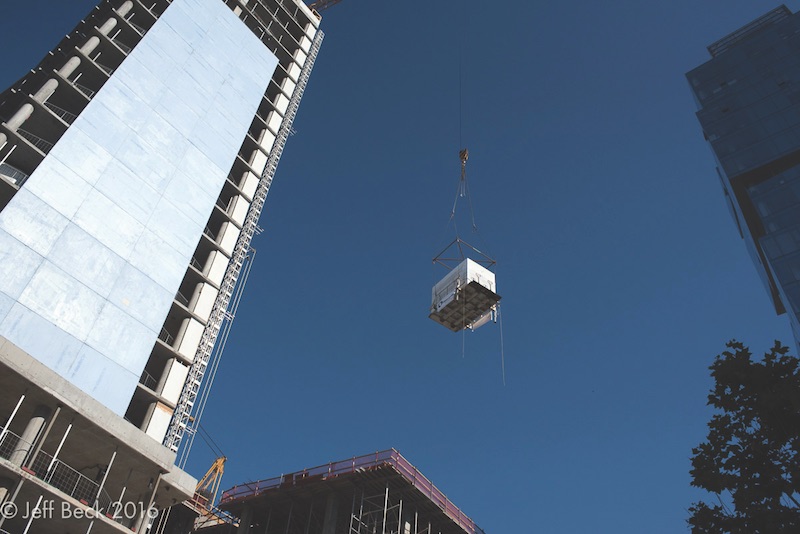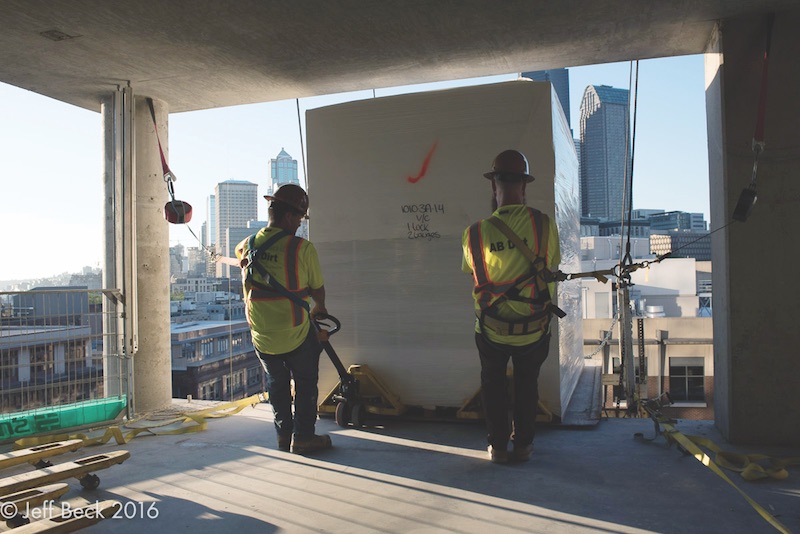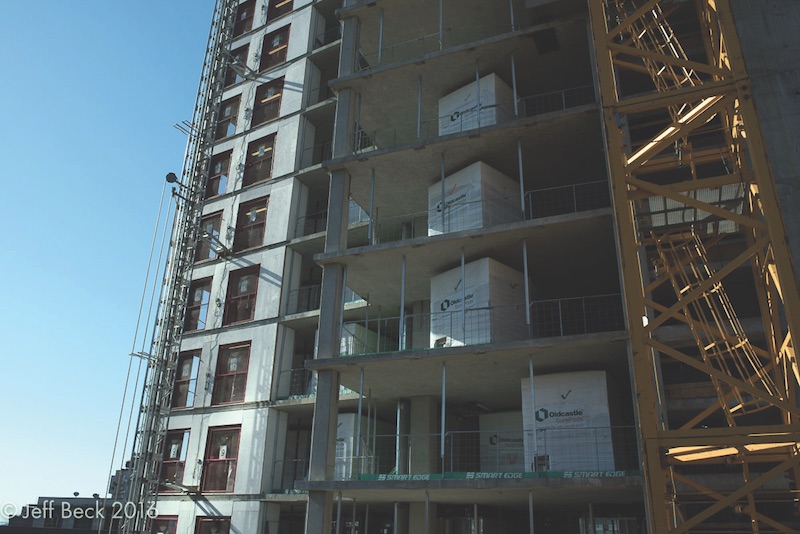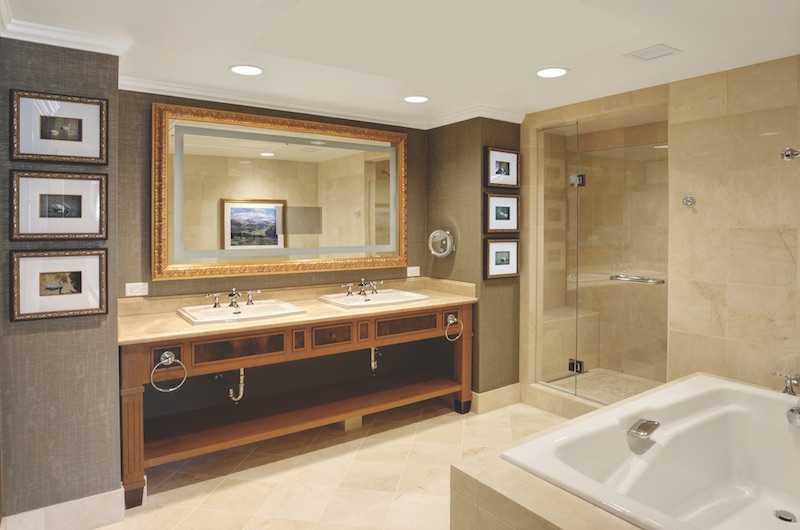There are still hurdles to overcome, but prefabrication techniques are steadily becoming more viable and widespread, as Building Teams realize the potential for labor, schedule, and even cost savings.
In order to receive the full benefits of designing and building with prefabrication techniques, such as bathroom pods, AEC firms should eye projects with repetitive layouts—hotels, student residence halls, in-patient towers, etc. “The more repetition, the more value there is in prefabricating,” says Ray Rigsby, Project Executive with Gilbane Building Co. “Any facility type that has repetitive floor plans lends itself to prefabrication.”
Bathrooms are a particularly good fit for prefabricated construction. Commercial projects such as hotels and student housing typically require large numbers of bathroom units with little or no variation unit to unit. And because bathroom dimensions meet road trucking size limits, the finished product can be shipped to the project site without having to be broken down into multiple components and reassembled on the job site.
(SEE ALSO: New white paper on modular bathroom pods offers insight on best uses)
Bathroom pods have also emerged as a pro tem solution to the construction industry’s ongoing labor shortage. “As a country, we have 1.5 million fewer trades people today than we did in 2007, when we had a similar level of construction activity going on,” says Bill Seery, Managing Director, Oldcastle SurePods, a bathroom pod manufacturer. “This is a structural change in the U.S. construction industry that is never going to go away.”
Rigsby agrees with this sentiment and believes prefabrication provides an answer. “The construction workforce is getting older, there are fewer workers coming into the trades, and there is an overall push to reduce labor costs,” he says. “Prefabrication will be used to offset this trend and in markets that are saturated with work to help offset a lack of workers.”
 Bathroom pods are moved into position at the Seattle Embassy Suites. Jeff Beck, Courtesy Oldcaste SurePods.
Bathroom pods are moved into position at the Seattle Embassy Suites. Jeff Beck, Courtesy Oldcaste SurePods.
Maximizing the Power of Pods
In order to optimize bathroom pods for a given project, the pods need to be incorporated into the design process early—no later than design documents, says Seery. Determine the pod details early—“Reworking details defeats the purpose of prefabrication,” says Rigsby—and start planning with a solid understanding of what the final product will be.
Rigsby and Seery offer additional tips and advice based on their decade-plus career working with prefab construction methods:
- All bathrooms should be the same size and shape. Any slight deviation, other than finishes, requires a new pod template.
- Ensure pod sizes are reflected correctly in the framing details.
- The pod supplier, architect, and contractor should perform a BIM conflict analysis to ensure there are no MEP clashes.
- Factor in site storage options and installation paths for the pods during preconstruction planning. Consider issues related to access to each floor level to allow rigging of the pods.
- Designers should consider the interface between the top of the pod and the ceiling structure to avoid any gaps or misalignment of utilities.
- Make sure all necessary connection points are accessible from the outside.
- Once installed, ensure the pod is squared and plumbed.
The more planning that goes into incorporating bathroom pods, the more beneficial they will be. Based on research and client feedback, Seery estimates that bathroom pods accelerate projects by roughly two months on average.
Rigsby says bathroom pods can also improve quality compared to traditional construction. “The quality control is better, and there are fewer varying conditions in the field and less day-to-day worker variation,” he says.
 The 282-room hotel is scheduled to open this summer. Jeff Beck, courtesy Oldcaste SurePods.
The 282-room hotel is scheduled to open this summer. Jeff Beck, courtesy Oldcaste SurePods.
evolution of the bathroom pod
A decade ago, bathroom pods were constructed with basically the same process as field-built bathrooms, just in a factory setting. Since that time, however, the process has been refined and streamlined.
“We now work natively in Revit for BIM, so we can provide pod models for the architect to drop directly into their building model,” says Seery. “Our Revit models translate directly into machine code for our production robots to produce many of our production pieces, which reduces labor and provides better overall tolerances and accuracy for the pods.”
The products used within the pods have also evolved and improved. SurePods, for example, has created a patent-pending, fully water- and crack-proof ceiling assembly that offers a five-year, no-crack warranty.
Increasingly sophisticated finishes and detailing have expanded the applications for bathroom pods, from suite apartments and dormitories to five-star hotels with complex, five-fixture setups.
“When we started in 2004, the technology to fully automate part of the design-to-manufacturing process did not exist,” says Seery, “nor did some of the more progressive materials we use today.”
 The project’s developer estimates that the use of bathroom pods shaved two months off of the construction schedule. Jeff Beck, courtesy Oldcaste SurePods.
The project’s developer estimates that the use of bathroom pods shaved two months off of the construction schedule. Jeff Beck, courtesy Oldcaste SurePods.
Related Stories
| Oct 18, 2013
Meet the winners of BD+C's $5,000 Vision U40 Competition
Fifteen teams competed last week in the first annual Vision U40 Competition at BD+C's Under 40 Leadership Summit in San Francisco. Here are the five winning teams, including the $3,000 grand prize honorees.
| Oct 15, 2013
Sustainable design trends in windows, doors and door hardware [AIA course]
Architects and fenestration experts are looking for windows and doors for their projects that emphasize speed to the project site, a fair price, resilient and sustainable performance, and no callbacks.
| Oct 7, 2013
10 award-winning metal building projects
The FDNY Fireboat Firehouse in New York and the Cirrus Logic Building in Austin, Texas, are among nine projects named winners of the 2013 Chairman’s Award by the Metal Construction Association for outstanding design and construction.
| Sep 24, 2013
8 grand green roofs (and walls)
A dramatic interior green wall at Drexel University and a massive, 4.4-acre vegetated roof at the Kauffman Performing Arts Center in Kansas City are among the projects honored in the 2013 Green Roof and Wall Awards of Excellence.
| Sep 20, 2013
Perimeter roof edge: The first line of defense in a wind event [AIA course]
Aside from the roof membrane itself, the perimeter roof edge is the most critical component of the roofing system. As such, it warrants more scrutiny when designing a roof system.
| Sep 19, 2013
What we can learn from the world’s greenest buildings
Renowned green building author, Jerry Yudelson, offers five valuable lessons for designers, contractors, and building owners, based on a study of 55 high-performance projects from around the world.
| Sep 19, 2013
Roof renovation tips: Making the choice between overlayment and tear-off
When embarking upon a roofing renovation project, one of the first decisions for the Building Team is whether to tear off and replace the existing roof or to overlay the new roof right on top of the old one. Roofing experts offer guidance on making this assessment.
| Sep 19, 2013
BIM 2.0 and Google Glass: Science fiction or coming attractions for a job site near you?
Todd Wynne of Rogers-O’Brien Construction is one of only 8,000 people around the globe granted a pair of Google Glass for testing. Here's what he's been up to with the technology.
| Sep 17, 2013
World's first 'invisible' tower planned in South Korea
The 1,476-foot-tall structure will showcase Korean cloaking technology that utilizes an LED façade fitted with optical cameras that will display the landscape directly behind the building, thus making it invisible.
| Sep 16, 2013
Study analyzes effectiveness of reflective ceilings
Engineers at Brinjac quantify the illuminance and energy consumption levels achieved by increasing the ceiling’s light reflectance.

















